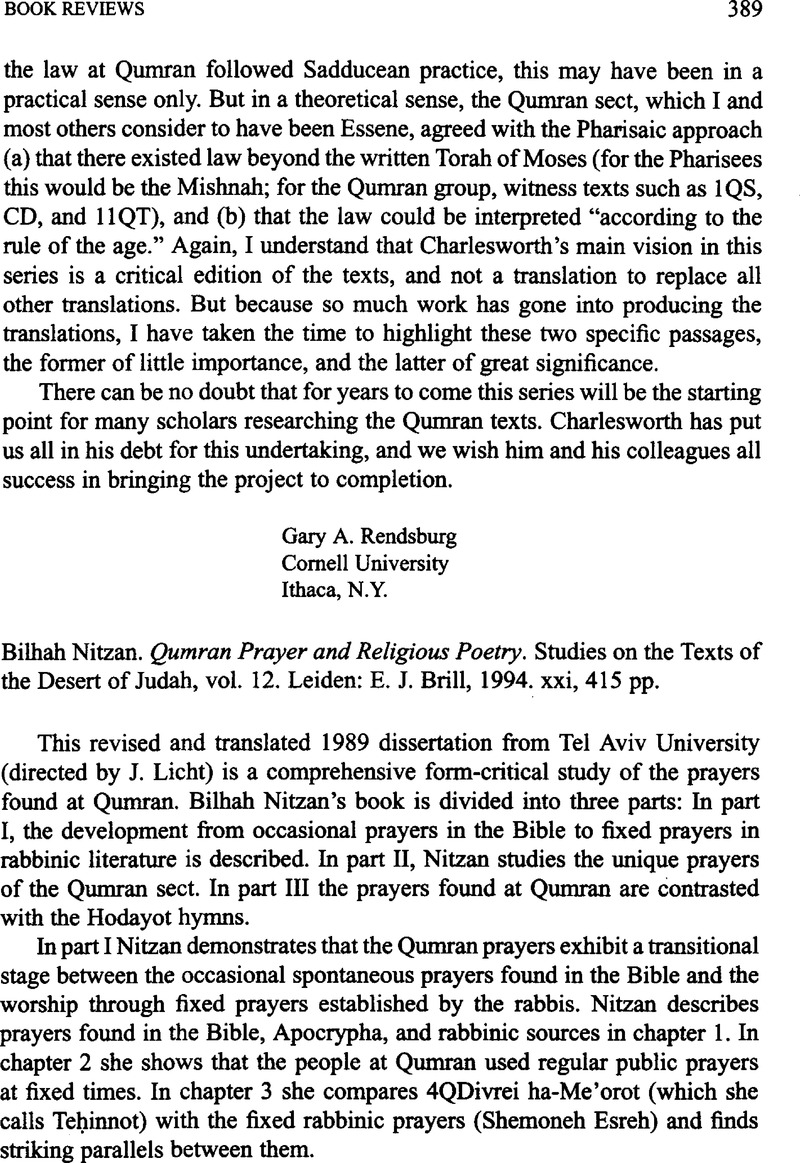No CrossRef data available.
Article contents
Bilhah Nitzan. Qumran Prayer and Religious Poetry. Studies on the Texts of the Desert of Judah, vol. 12. Leiden: E. J. Brill, 1994. xxi, 415 pp.
Published online by Cambridge University Press: 15 October 2009
Abstract

- Type
- Book Reviews
- Information
- Copyright
- Copyright © Association for Jewish Studies 1996
References
1. Fleischer, E., “On the Beginnings of Obligatory Jewish Prayer,” Tarbiz 59 (1990): 397–441.Google Scholar
2. Eshel, H., “The Prayer of Joseph from Qumran, a Papyrus from Masada, and the Samaritan Temple on APrAPIZIN,” Zion 56 (1991): 129, n. 9.Google Scholar
3. Newsom, C., “‘Sectually Explicit’ Literature from Qumran,” in The Hebrew Bible and Its Interpreters, ed. Propp, W. H., Halpern, B. and Freedman, D. N. (Winona Lake, Ind., 1990), pp. 167–197. On Divrei ha-Me′orot, see alsoGoogle ScholarChazon, E., “Is Divrei ha me orot a Sectarian Prayer?” in The Dead Sea Scrolls: Forty Years of Research, ed. Dimant, D. and Rappaport, U. (Leiden, 1992), pp. 3–17.Google Scholar
4. Eshel, E., Eshel, H., and Yardeni, A., “A Qumran Composition Containing Part of Ps. 154 and a Prayer for the Welfare of King Jonathan and His Kingdom,” Israel Exploration Journal 42 (1992): 199–229.Google Scholar
5. As noted by Puech, E., “HQPsApa: Un rituel d′exorcismes: Essai de reconstruction,” Revue de Qumran 14 (1990): 377–408.Google Scholar In her discussion of this prayer, Nitzan accepts all of the reconstructions made by Puech. In general, Nitzan accepts most of the readings and reconstructions of the editors of the prayers found in Qumran, and thus does not offer corrections or reconstructions of her own.
6. For the assumption that these scrolls were used for liturgical prayers, see Eshel, E., “4QDeuta: A Text That Has Undergone Harmonistic Editing,” Hebrew Union College Annual 62 (1992): 151–152;Google ScholarWeinfeld, M., “Prayer and Liturgical Practice in the Qumran Sect,” in The Dead Sea Scrolls: Forty Years of Research, ed. Dimant, D. and Rappaport, U. (Leiden, 1992), pp. 229–240; and J. A. Duncan, “Considerations of the Text of 4QDtj in Light of the ‘All Souls Deuteronomy’ and Cave 4 Phylactery Texts,” in The Madrid Qumran Congress: Proceedings of the International Congress on the Dead Sea Scrolls, Madrid, 18–21 March 1991,, ed. J. Trebolle Barrera and L. Vegas Montaner, vol. 1 (Madrid, 1992), pp. 199–121.Google Scholar
7. Goshen-Gottstein, M. H., “The Psalms Scrolls (1 lQPsa): A Problem of Canon and Text,” Textus 5 (1966): 22–33;Google ScholarSkehan, P. W., “A Liturgical Complex in HQPsa,” Catholic Bible Quarterly 35 (1973): 195–205;Google Scholar and Haran, M., “HQPsa and the Canonical Book of Psalms,” in Minha le-Nahum: Biblical and Other Studies Presented to Nahum M. Sarna in Honor of His 70th Birthday, ed. Brettler, M. and Fishbane, M. (Sheffield, 1993), pp. 193–201.Google Scholar
8. It is very hard to accept the view that the same group of people who recited the Grace over the Meal on a regular day by quoting verses from Deuteronomy would have, in a case of mourning, a fixed prayer as Grace after the Meal which is not based on biblical verses. See Weinfeld, M., “Grace after Meals in Qumran,” Journal of Biblical Literature 111(1992): 417–439CrossRefGoogle Scholar




